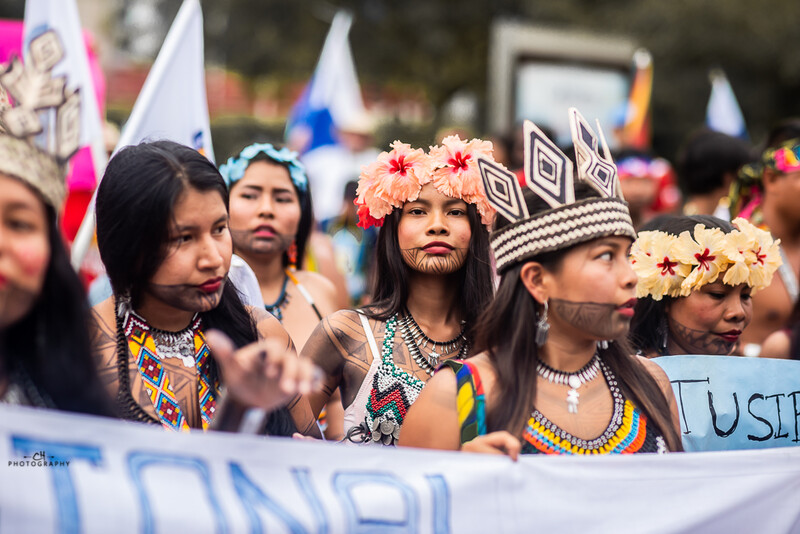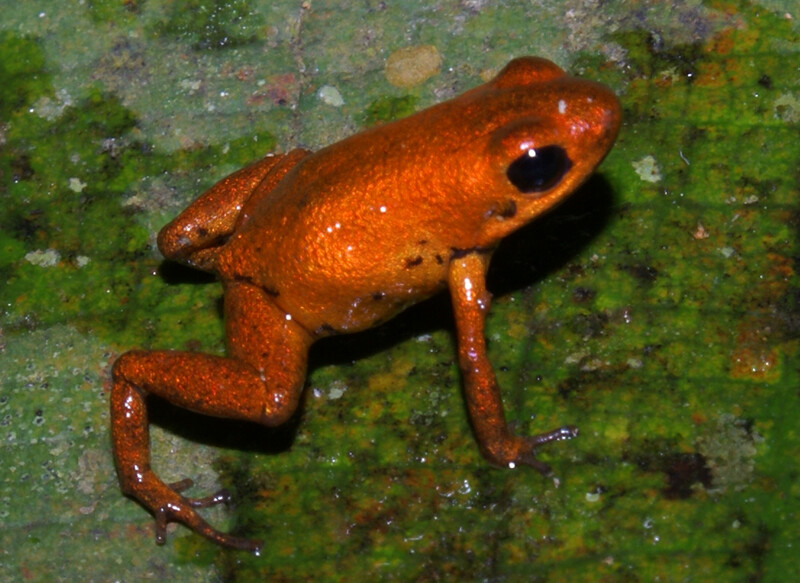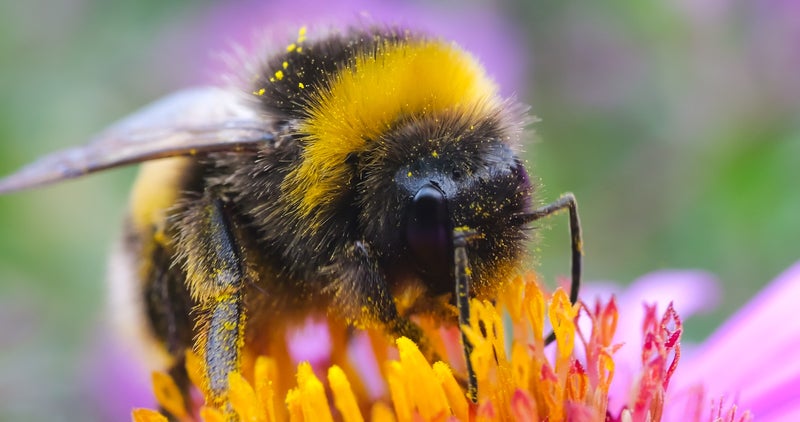On November 24, Panama’s Supreme Court will decide the future of an open-pit mine bigger than Manhattan that continues to endanger the rights, health and livelihoods of local communities; threatens an irreplaceable place that is critical for biodiversity and climate; and has been the focus of the historic country-wide protests since mid-October.
A group of international and local conservation organizations and activists today joins the overwhelming majority of the country in opposing the 50-square-mile (13,000 hectare) copper, gold, silver and molybdenum mine, which is operated by Minera Panamá, a subsidiary of Canadian company First Quantum Minerals. Together the National Coordinator of Indigenous Peoples of Panama (COONAPIP), Audubon de Panamá, ADOPTA Bosque Panamá, Panamá Sostenible, Centro de Incidencia Ambiental (CIAM Panama), Re:wild, the Amphibian Survival Alliance, Synchronicity Earth, WWF, American Bird Conservancy, the IUCN SSC Amphibian Specialist Group, and BirdLife International join Panama’s local and Indigenous communities in urging the Supreme Court to follow the law and declare the new contract with Minera Panamá unconstitutional.
“When all this nature is contaminated, we all die,” said Rengifo Navas Revilla (who goes by Sagla Dummad), secretary of COONAPIP and a leader in Panama’s Guna Indigenous community. “Even the planet itself, even Mother Earth herself, dies. This is the principle that has been instilled in us and that is why we continue to fight. This is why we Indigenous peoples are asking the Supreme Court to declare this law unconstitutional.”
The Minera Panamá project is located in the province of Colón, in the Donoso Protected Area, which is within the globally important Golfo de los Mosquitos Forests Key Biodiversity Area. Key Biodiversity Areas (KBAs) are sites critical to the global persistence of biodiversity and the health of the planet. The Panamanian government is bound by law to safeguard protected areas like Donoso. Panama’s Congress and President Laurentino Cortizo Cohen recently awarded a new contract to Minera Panamá to continue its operations after a first Supreme Court decision declared the previous contract violated the constitution.
More than 1,000 species of wildlife live in the Donoso Protected Area, many of which are threatened with extinction, according to the IUCN Red List of Threatened Species. This includes the great green macaw, Baird’s tapir, Central American spider monkey, jaguar, harpy eagle (Panama’s national bird), horned marsupial frog, and the critically endangered Gemini’s dart frog, a species only described in 2014 and whose entire known habitat is in the Donoso Protected Area, near the mining project. Because of this species, the Golfo de los Mosquitos Forests KBA is also recognized as an Alliance for Zero Extinction site, the most irreplaceable subset of Key Biodiversity Areas. A small group of Gemini’s dart frogs were first brought into a conservation breeding program in 2014, but there have been no scientific records of the species since 2018.
“Unfortunately, after its last assessment in 2018, five years of continual mining operations have taken place so close to the last-known remaining population of this species, therefore, we aren’t sure how many--if any--individuals are left and urgently need to assess the status of the frog in the wild,” said Gina Della Togna, executive director of the Amphibian Survival Alliance. “We call upon all national and international stakeholders to come together to find sustainable solutions that prioritize the protection of the Gemini’s dart frog and this invaluable ecosystem.”
The mine is also located in the heart of the Panama Atlantic Mesoamerican Biological Corridor, which connects wildlife habitat in seven countries of Central America to southern Mexico. Ecological corridors are critical for animals to be able to move to find food, habitat and mates. A road that was built for the mine crosses the corridor, disrupting the connectivity of forests in the region. More than 11.6 square miles (3,000 hectares) of forest have already been destroyed for the construction and operation of the mine.
“The area to be destroyed by this mining contract is one of the most biodiverse and least-known rainforests in all of Panama,” said Guido Berguido, a Panamanian biologist and executive director of Adopta Bosque Panamá. “Just this year a new species in the Brazilnut family (Eschweilera magnifica) was described from the mine site, and other species of plants and animals are being described as we speak. Our greatest fear is that, with current deforestation and the projected expansion of the mining operation, some wildlife species may go extinct before they are even discovered.”
According to the science-based organization, Science in Panama, open-pit mining can generate both significant air pollution that can cause severe respiratory illnesses in people, and waste rock that contains heavy metals that are washed away and can contaminate nearby waters. When the water polluted with heavy metals is consumed, it can result in neurological damage, cancer and other health challenges. Mines also release 1.4 times more particulate matter into nearby communities compared to non-mining sites. Particulate matter is especially damaging to the immature lungs of children and can result in death.
The original concession for the mine was granted in 1997 and went through two previous owners before First Quantum Minerals took over in 2013, inheriting the original contract. In 2009, two lawsuits were filed over the constitutionality of the original contract. In 2017, Panama’s Supreme Court ruled that the original concession was unconstitutional in part because it was granted without the proper bidding process in place.
Despite the ruling, the company began exporting copper in 2019. First Quantum negotiated a new contract to continue operations and add an additional 15.4 square miles (4,000 hectares) to the size of the project, which Congress approved and President Cortizo signed into contract-law on Oct. 20, 2023, which is when the protests across the country escalated.
Now all eyes are on the Supreme Court, which has received nine lawsuits around the constitutionality of the contract. Its decision could quash the contract. The court, which publicly assigned top priority to this case, has said that it will announce its decision about the first cases on Nov. 24, one day after the 10-day period for interested parties to submit comments closes.
Congress and the president approved the contract-law a little more than one year after Panama’s National Assembly and President Cortizo signed legislation granting nature “the right to exist, persist and regenerate its life cycles.” According to the law, which went into effect earlier this year, Panama’s parliament must consider the impact of its policies on nature.
“Panama is an example of the growing desire of Mesoamerican peoples to protect biodiversity and develop sustainable economic alternatives that move away from extractive industry and deforestation,” said Esteban Brenes-Mora, Re:wild senior Mesoamerica associate. “The people of Panama see the value of nature and are standing up for their rights and the rights of their wildlife and wildlands. Now we hope the Supreme Court judges will do the same and protect an ecosystem that is critical for people, wildlife and a stable climate.”
Additional quotes
Raisa Banfield, Panamanian environmental activist "Panama wakes up after 26 years of an inflicted unconstitutional mega-mining contract. Environmental organizations and legal experts have been voicing their concerns and raising awareness about the damages of open-pit metal mining for more than 15 years. The recent government imposition raises concerns, especially among young people and the resistance of our Indigenous brothers and sisters. The calls ‘Panama Worth More Without Mining’ and ‘Panama Is Not For Sale’ have united the Panamanian people to defend our home.”
Rosabel Miró, executive director, Sociedad Audubon de Panamá “The harpy eagle, our national bird, and the bare-necked umbrellabird, a local altitudinal migrant, are found in the Golfo de los Mosquitos Forests KBA and are huge draws for avitourism. Several other birds in this area, in addition to these two, are listed as vulnerable or endangered species. These forests are also important stopover sites for many migratory birds such as Canada warblers. Mining is not the best use of this land. Developing birding and nature- based tourism, an industry that respects both the environment and the people of Panama, is what we recommend and support.”
Abel Batista, Panamanian herpetologist who was part of the team that discovered Gemini’s dart frog in 2010 “Gemini’s dart frog is a symbol of the unique value of what we are losing in Panama because of this mine. Our leaders cannot be passive about protecting this species and all of the others that depend on the Panama Atlantic Mesoamerican Biological Corridor.”
Amaël Borzée, co-chair of the IUCN SSC Amphibian Specialist Group, and professor at the Laboratory of Animal Behaviour and Conservation, College of Biology and the Environment, Nanjing Forestry University “Given the extensive evidence of amphibians being the most threatened vertebrates on Earth and their benefits to humanity, it is critical that we safeguard their habitat and that we do everything possible to prevent the extinction of even one additional amphibian species.”
Amy Upgren, director of international programs, American Bird Conservancy “As a Key Biodiversity Area and Alliance for Zero Extinction (AZE) site, this globally recognized area is also important for the survival of the great green Macaw, a rapidly declining bird species with a population estimate of a few thousand individuals. We support the efforts of so many Panamanians striving to cancel the mining contract to safeguard the rights, health, and livelihoods of local and Indigenous communities along with the preservation of this significant ecosystem.”
Joana Abrego, legal manager, Centro de Incidencia Ambiental / Environmental Advocacy Center “It is time for the Supreme Court to not only defend nature and local communities, but also to uphold its place as a counterweight to the Executive and Legislative branches. It is imperative that the rule of law be restored so we can focus on how to face local and global environmental crises, finally implementing not only in word, but in action, the laws that are passed in favor of the environment. Panamanian authorities can no longer remain as green and blue leaders to the international community and as constant defenders of ‘economic growth’ over environmental protection at the national level.”
# # #
Photos (from top left, clockwise): Protests in Panama (photo by @enlayesk507); harpy eagle (photo by Greg Homel, Natural Elements Productions); Donoso Protected Area (photo by TV Indígena and Wagua Films); Gemini’s dart frog (photo by Jaime Culebras, Photo Wildlife Tours). Download photos and video
Re:wild Re:wild protects and restores the wild. We have a singular and powerful focus: the wild as the most effective solution to the interconnected climate, biodiversity and human wellbeing crises. Founded by a group of renowned conservation scientists together with Leonardo DiCaprio, Re:wild is a force multiplier that brings together Indigenous peoples, local communities, influential leaders, nongovernmental organizations, governments, companies and the public to protect and rewild at the scale and speed we need. Learn more at rewild.org.
National Coordinator of Indigenous Peoples of Panama (COONAPIP) The National Coordinator of Indigenous Peoples of Panama (COONAPIP) is an organisation made up of the indigenous peoples of Panama and led by their traditional authorities.
ADOPTA BOSQUE Asociación Adopta el Bosque Panamá (Adopt a Panama Rainforest) is a Panamanian nonprofit charity organization promoting conservation and sustainable use of Panama´s unique tropical ecosystems for the benefit of both People and Wildlife; through scientific research, environmental education, habitat acquisitions, and community participation. Social Media @AdoptaBosque
American Bird Conservancy American Bird Conservancy is a nonprofit organization dedicated to conserving wild birds and their habitats throughout the Americas. With an emphasis on achieving results and working in partnership, we take on the greatest problems facing birds today, innovating and building on rapid advancements in science to halt extinctions, protect habitats, eliminate threats, and build capacity for bird conservation. Find us on abcbirds.org, Facebook, Instagram, and Twitter (@ABCbirds).
Amphibian Survival Alliance The Amphibian Survival Alliance (ASA) is a global partnership dedicated to the conservation of amphibians and their habitats. Committed to a future where amphibians thrive in nature, ASA collaborates with a network of partners to develop and implement effective conservation actions. ASA focuses on six key priorities: community engagement and education, organizational excellence and sustainability, strengthening partnerships for greater impact, enhancing conservation outcomes, resource mobilization and fundraising, and policy advocacy and global influence. ASA aims to mitigate and prevent amphibian declines while fostering an informed and active community. For more information, visit amphibians.org.
BirdLife International BirdLife International is the largest and oldest international alliance for the conservation of birds and their habitats, with 101 years of longevity. It has 120 partners around the planet and 23 in the Americas who work with passion and commitment to protect birds, biodiversity, their habitats, and people. BirdLife is recognized for its leadership in identifying and formulating Important Bird Areas and Key Biodiversity Areas (IBAs and KBAs, respectively). BirdLife's approach allows us to articulate strategic conservation and restoration actions based on science and community development that go beyond borders along the migratory bird routes. It has six regional offices (Quito, Brussels, Amman, Nairobi, Singapore, and Suva) and a global office in Cambridge, United Kingdom. Join the flock and learn more at www.birdlife.org.
Centro de Incidencia Ambiental de Panamá / Environmental Advocacy Center of Panama Our center was founded in 2007 by Panamanian civil society to address legal actions of public interest, including taking cases to the Supreme Court, in search of environmental justice. We defend the human right to a healthy environment, we focus on strategic litigation, environmental advocacy and promoting citizen participation.
We provide legal assistance - free of charge - to the most vulnerable communities due to environmental impacts. www.ciampanama.org @ciampanama in social media platforms.
IUCN SSC Amphibian Specialist Group The IUCN SSC Amphibian Specialist Group isp is a network of professionals providing the science supporting the conservation of amphibians, locally and globally. Given the threats to the Key Biodiversity Area and Alliance for Zero Extinction site, and the resulting threats to the Critically Endangered Gemini’s dart frog (Andinobates geminisae), the ASG recommend preserving the environment of all threatened species to prevent extinctions and mitigate biodiversity losses.
Sociedad Audubon de Panamá/Panama Audubon Society Sociedad Audubon de Panamá is a membership-based conservation organization founded in 1968 that promotes active and responsible participation of citizens in the conservation and sustainable use of natural resources in Panama. Its mission is to stimulate appreciation for wildlife, with emphasis on birds, by encouraging their observation and study. The tools it uses are environmental education, research, advocacy and community participation For more information visit www.audubonpanama.org, and @audubonpanama on Facebook, Instagram and Twitter.
Sustainable Panama Sustainable Panama is a foundation created to articulate actors and sustainable actions to counteract bad practices, and thus promote environmental education and communication for the transformation of Panama.
Synchronicity Earth Synchronicity Earth is a UK-based conservation charity that acts to address overlooked and underfunded conservation challenges for globally threatened species and ecosystems.
WWF WWF is an independent conservation organisation, with over 30 million supporters and a global network active in over 100 countries. WWF's mission is to stop the degradation of the Earth's natural environment and to build a future in which humans live in harmony with nature, by conserving the world's biological diversity, ensuring that the use of renewable natural resources is sustainable, and promoting the reduction of pollution and wasteful consumption. Visit www.panda.org/news for the latest news and media resources and follow us on Twitter @WWF_media.














Devin Murphy
Writer
Devin Murphy is Re:wilds’s senior communications specialist and helps Re:wild and its partners tell stories about the work they do to protect wildlife and wildlands around the planet. Her favorite stories about conservation include fascinating and little-known species and the dedicated humans protecting them.




